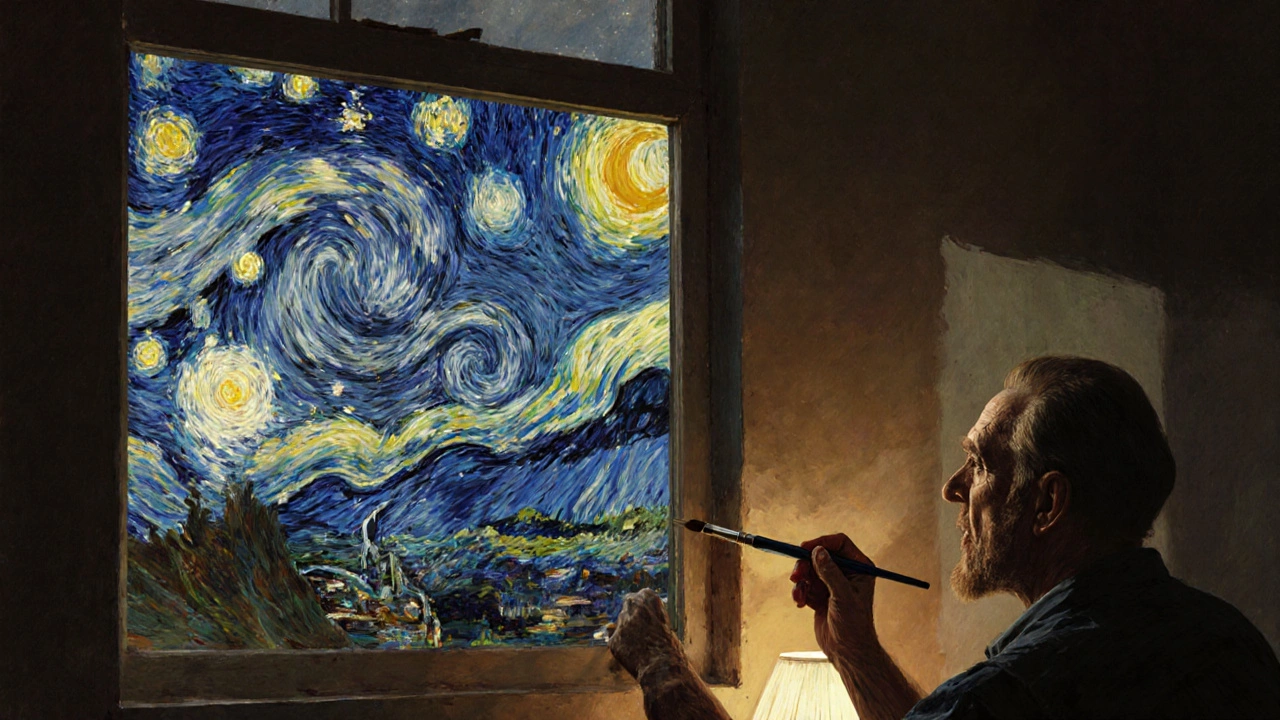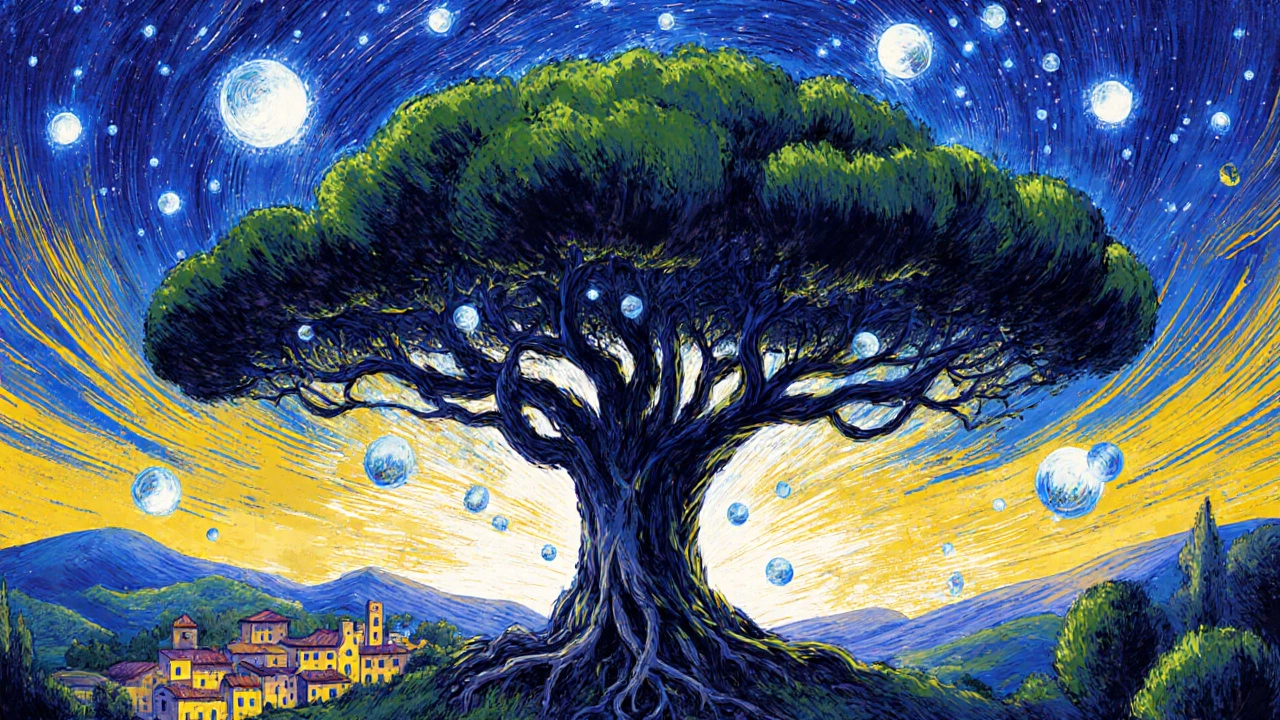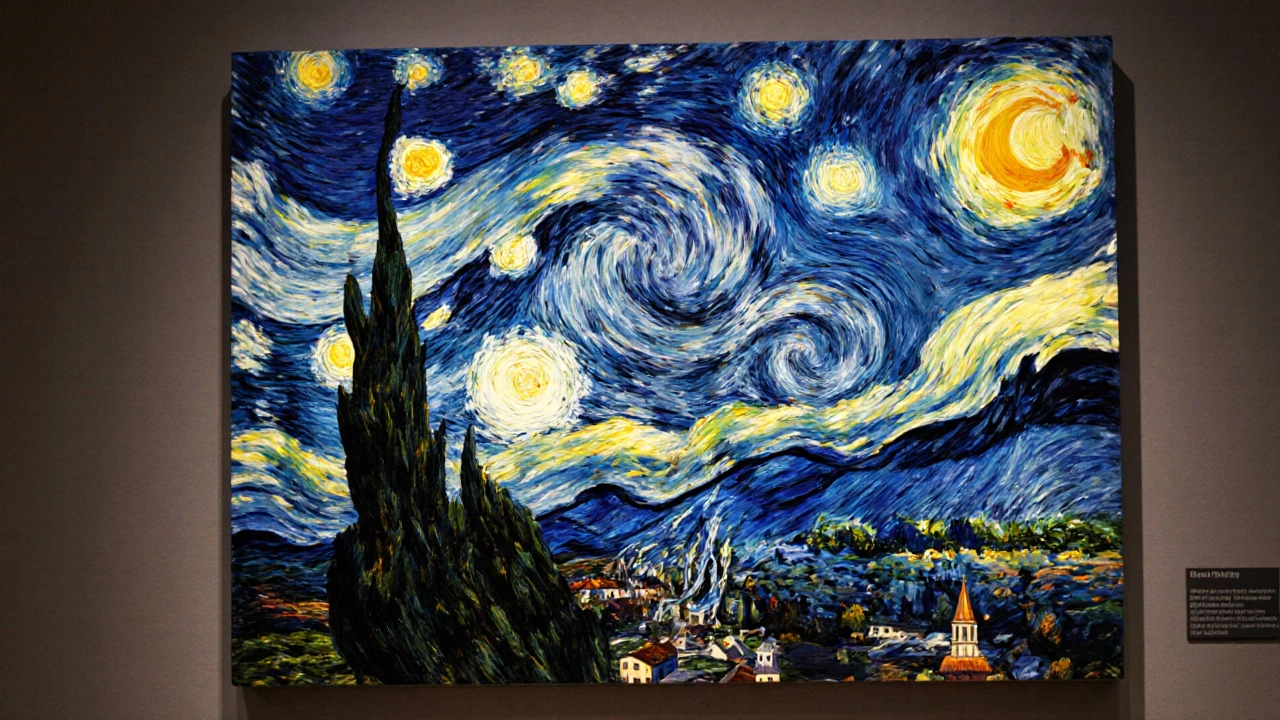When you look at Vincent van Gogh’s Starry Night, you see swirling skies, glowing stars, and a sleepy village curled beneath a cosmic storm. It’s emotional. It’s dramatic. And for many, it feels abstract. But is it really? The answer isn’t as simple as yes or no - and that’s where the confusion starts.
What Makes Art Abstract?
Abstract art doesn’t try to copy the real world. It breaks away from recognizable shapes, colors, and forms to express emotion, energy, or ideas. Think of Wassily Kandinsky’s floating shapes or Mark Rothko’s color fields. No trees. No houses. No faces. Just feeling made visible.
But Starry Night has a village. It has a cypress tree. It has a church steeple. You can point to them. You can name them. That’s not abstract. That’s representation - even if it’s wildly distorted.
Van Gogh Wasn’t Painting What He Saw - He Was Painting What He Felt
Van Gogh painted Starry Night in June 1889 from his room at the Saint-Paul-de-Mausole asylum in Saint-Rémy, France. He wasn’t painting the view from his window exactly. He added the swirling sky, exaggerated the stars, and twisted the cypress into a dark flame. He wrote to his brother Theo: “I don’t know whether I’ll ever finish it… but I’m trying to express something more than just a landscape.”
That’s the key. He didn’t abandon reality. He twisted it. He amplified it. He turned the night sky into a living, breathing force. That’s not abstraction. That’s post-impressionism.
Post-Impressionism vs. Abstract Art
Post-impressionism came after impressionism. Artists like Van Gogh, Paul Cézanne, and Paul Gauguin kept the real world as a starting point - but they changed it. Color became emotional. Brushstrokes became movement. Form became symbolic.
Abstract art, which fully emerged in the early 1900s, came later. Kandinsky’s first abstract painting was in 1910 - over 20 years after Starry Night. By then, artists were removing recognizable subjects entirely. Van Gogh never went that far. His subjects were always there, even when they bent under emotion.
So while Starry Night looks like it could be abstract, it’s rooted in observation. It’s not a dream. It’s a vision - filtered through pain, wonder, and obsession.

Why Do People Think It’s Abstract?
Because it feels abstract. The sky doesn’t look like any sky you’ve ever seen. The stars pulse like they’re alive. The hills roll like waves. The brushwork is so thick, so urgent, it seems to vibrate. Our brains want to label that as “abstract” because it’s overwhelming.
But that’s a misunderstanding of the term. Abstract doesn’t mean “weird.” It doesn’t mean “emotional.” It means “non-representational.” If you can’t identify a tree, a person, or a building - then it’s abstract. In Starry Night, you can. The church is there. The cypress is there. The hills are there. They’re just painted with fire in their veins.
The Cypress Tree: A Bridge Between Worlds
The dark, flame-like cypress in the foreground is often overlooked. It’s the only thing that connects the earth to the sky. It’s rooted in the ground, yet it reaches up like a prayer. Van Gogh loved cypresses. He painted them over and over. To him, they were symbols of death - but also of eternity.
This isn’t abstraction. It’s symbolism. He used a real object to carry meaning. That’s how artists have worked for centuries. It’s not the same as Kandinsky removing the cypress entirely and replacing it with a red circle.
What If Van Gogh Had Painted Only Swirls?
Imagine if he’d left out the village. If the cypress was just a black swirl. If the stars were color blobs with no halos. If there was no horizon. Then yes - that would be abstract. But he didn’t. He held onto the world. He just made it scream.
That’s why Starry Night sits in a strange space. It’s not abstract. But it’s not realistic either. It’s somewhere in between - a bridge between seeing and feeling. That’s why it’s so powerful.

Where Does It Belong?
Starry Night is classified in museums as post-impressionist. It’s in the collection of the Museum of Modern Art in New York under that label. Art historians don’t call it abstract. Critics don’t call it abstract. Even the museum’s wall text doesn’t call it abstract.
It’s a masterpiece of emotional realism. It’s not about escaping the world - it’s about seeing it more deeply than anyone else could.
What About Modern Artists Who Call It Abstract?
Sometimes, modern viewers, especially those new to art, use “abstract” as a catch-all for anything that looks unusual. That’s understandable. But it’s imprecise. It’s like calling a symphony “noisy” because it’s loud. The label loses meaning when it’s used too broadly.
Art movements have definitions for a reason. They help us understand how artists thought, what they were reacting to, and what they were trying to do. Calling Starry Night abstract erases Van Gogh’s intention. It turns his struggle into decoration.
So, Is Starry Night Abstract?
No. It’s not abstract. It’s post-impressionist. It’s emotional. It’s intense. It’s one of the most expressive paintings ever made. But it still shows the world - just through the eyes of a man who saw it differently.
If you want abstract art, look to Kandinsky, Mondrian, or Pollock. They removed the world on purpose. Van Gogh didn’t. He held onto it - and made it unforgettable.
Is Starry Night considered modern art?
Yes, but with nuance. Van Gogh painted it in 1889, which places it before what’s typically called "modern art" - that movement started around 1900. So technically, it’s late 19th century. But because it broke so many rules of traditional painting, it became a foundation for modern art. Museums often group it with modern art for practical reasons, but art historians separate it as post-impressionism.
Why do so many people think Starry Night is abstract?
Because the sky looks unreal. The swirls, the glowing stars, the thick brushstrokes - they feel like a dream. People confuse emotional intensity with abstraction. But abstract art removes recognizable objects. Starry Night keeps them - it just bends them. It’s not fantasy. It’s heightened reality.
Can something be abstract and representational at the same time?
Not in strict art history terms. Representational art shows real things - even if distorted. Abstract art doesn’t. There’s a line between exaggeration and elimination. Van Gogh exaggerated. Abstract artists eliminated. Some contemporary artists blur the line, but in 1889, that line was clear. Starry Night is on the representational side.
What’s the difference between post-impressionism and expressionism?
Post-impressionism came first, around 1880-1900. Artists like Van Gogh and Gauguin kept real subjects but changed color and form for emotional effect. Expressionism came later, around 1905-1920, and was more extreme. Expressionists like Munch and Kirchner often distorted figures to show inner turmoil. Starry Night is post-impressionist because it still shows a real place - just through Van Gogh’s emotional lens.
Does the fact that Van Gogh painted it from memory make it abstract?
No. Many artists paint from memory. Monet painted his water lilies from memory. Degas painted dancers from memory. Memory doesn’t equal abstraction. It just means the artist wasn’t copying what was in front of them. Van Gogh used memory to enhance emotion - not to erase reality. The village, the church, the cypress - all real elements. He just made them sing.

